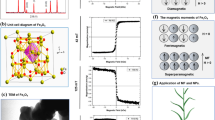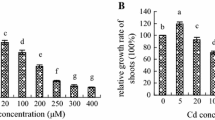Abstract
To alleviate toxicological effect induced by cadmium in mungbean seedlings, seeds were divided into four groups: The controls groups (CK, without treatment), magnetic field treated groups (MF), cadmium treated groups (CS), and magnetic field treated followed by cadmium treated groups (MF + CS).The results showed: (i) Compared with the controls, cadmium stress resulted in enhancing in the concentration of malondialdehyde, H2O2 and O2−, and the conductivity of electrolyte leakage while decreasing in the nitrice oxide synthase (NOS) activity, the concentration of nitrice oxide (NO), chlorophyll and total carbon and nitrogen, the net photosynthetic rate, the stomatal conductance, the transpiration rate, the water use efficiency, the lateral number and seedlings growth except for intercellular CO2 concentration increase. However, the seedlings treated with 600 mT magnetic field followed by cadmium stress the concentration of malondialdehyde, H2O2 and O2−, and the conductivity of electrolyte leakage decreased, while the above mentioned NO concentration, NOS activity, photosynthesis and growth parameters increased compared to cadmium stress alone. (ii) Compared with the cadmium stress (CS), the seedling growth were inhibited when the seeds were treated with NO scavenger (hemoglobin, HB) and inhibition of NO generating enzyme (sodium tungstate, ST), conversely, the seedling growth were improved by the NO donor sodium nitroprusside (SNP) and CaCl2. In the case of the HB and ST treatment followed by magnetic field and then the seedling subjected to CS, the seedlings growth was better than that of hemoglobin (HB) followed by CS and ST followed by CS. The seeds were treated with SNP and CaCl2 followed by MF, and then subjected to CS, the seedlings growth were better than that of SNP followed by CS, and CaCl2 followed by CS. These results suggested that magnetic field compensates for the toxicological effects of cadmium exposure are related to NO signal.





Similar content being viewed by others
Abbreviations
- MDA:
-
Malondialdehyde
- TBA:
-
Thiobarbituric acid
- NO:
-
Nitrice oxide
- NOS:
-
Nitrice oxide synthase
- Pn:
-
Net photosynthetic rate
- Gs:
-
Stomatal conductance
- Tr:
-
Transpiration rate
- Ci:
-
Intercellular CO2 concentration
- EDTA:
-
Ethylene diamine tetraacetic acid
- CK:
-
Without any treatment
- MF:
-
Magnetic field treatment
- CS:
-
Cadmium stress
References
Ahmet E (2003) Effects of magnetic fields on yield and growth in strawberry ‘camarosa’. J Hort Sci Biotechnol 78:145–147
Akoyunoglou G (1964) Effect of a magnetic field on carboxydimutase. Nature 4931:452–454
Atal N, Sardini PP, Mohanty P (1993) Inhibition of the chloroplast photochemical reactions by treatment of wheat seedlings with low concentrations of cadmium: analysis of electron transport activities and changes in fluorescence yield. Plant Cell Physiol 32:943–951
Bajji M, Kinet JM, Lutts S (2002) Osmotic and ionic effects of NaCl on germination, early seedling growth, and ion content of Atriplex halimus (Chenopodiaceae). Can J Bot 80:297–304
Baryla A, Carrier P, Franck F, Coulomb C, Sahut C, Havaux M (2001) Leaf chlorosis in oilseed rape plants (Brassica napus) grown on cadmium-polluted soil: causes and consequences for photosynthesis and growth. Planta 212:696–709
Belyavskaya NA (2001) Ultrastructure and calcium balance in meristem cells of pea roots exposed to extremely low magnetic fields. Adv Space Res 28:645–650
Bolwell GP, Blee KA, Butt VS, Davies DR, Gardner SL, Gerrish C, Minibayeba F, Rowntree EG, Wojtaszek P (1999) Recent advances in understanding the origin of the apoplastic oxidative burst in plant cells. Free Radic Res 31:137–145
Chaves MM, Maroco JP, Pereira JS (2003) Understanding plant responses to drought from genes to the whole plant. Funct Plant Biol 30:239–264
Cornic G (2000) Drought stress inhibits photosynthesis by decreasing stomatal aperture-not by affecting ATP synthesis. Trends Plant Sci 5:187–188
Creanga DE, Morariu VV, Lsac RM (2002) Life in zero magnetic fields IV. Investigation of developmental effects on fruit fly vision. Electromagn Biol Med 21:31–41
De Filippis LF, Ziegler H (1993) Effect of sublethal concentrations of zinc, cadmium and mercury on the photosynthetic carbon reduction cycle of Euglena. J Plant Physiol 142:167–172
Delledonne M, Xia Y, Dixon RA, Lamb C (1998) Nitric oxide functions as a signal in plant disease resistance. Nature 394:585–588
Fodor A, Szabó-Nagy A, Erdei L (1995) The effects of cadmium on the fluidity and H+-ATPase activity of plasma membrane from sunflower and wheat roots. J Plant Physiol 14:787–792
Gadallah MAA (1995) Effects of cadmium and kinetin on chlorophyll content, saccharides and dry matter accumulation in sunflower plants. Biol Plant 37:233–240
Gao JF (2001) Method of determine O2 − in plant. Technology of Plant Physiological Experiment, High Education Press, Beijing, pp 221–222
Kavi PS (1977) The effect of magnetic treatment of soybean seed on its moisture absorbing capacity. Sci Cult 43:405–406
Lebedev IS, Litvinenko LG, Shiyan LT (1977) After-effect of a permanent magnetic field on photochemical activity of chroloplasts. Soviet Plant Physiol. 24:394–395
Lednev VV (1996) Bioeffects of weak combined, static and alternating magnetic fields. Biofizika 41:224–232 (in Russian)
Lin ZF (1988) The accumulation of hydrogen peroxide in senescing leaves and chloroplasts in relation to lipid peroxidation. Acta Phytophysiol Sin 14:16–22
Meloni DA, Oliva MA, Martinez CA, Cambraia J (2003) Photosynthesis and activity of superoxide dismutase, peroxidase and glutathione reductase in cotton under salt stress. Environ Exp Bot 49:69–76
Murphy JD (1994) The influence of magnetic fields on seed germination. Am J Bot 29:155
Murphy ME, Noack E (1994) Nitric oxide assay using haemoglobin method. Method Enzymol 233:240–250
Padmaja K, Prasad DDK, Prasad ARK (1990) Inhibition of chlorophyll synthesis in Phaseolus vulgaris L. seedlings by cadmium acetate. Photosynthetica 24:399–405
Piacentini MP, Fraternale D, Piatti E, Ricci D, Vetrano F, Dacha M, Accorsi A (2001) Senescence delay and change of antioxidant enzyme levels in Cucumis sativus L. etiolated seedlings by ELF magnetic fields. Plant Sci 161:45–53
Pietruszewski S (1993) Effect of magnetic seed treatment on yields of wheat. Seed Sci Technol 21:621–626
Prasad MNV (1995) Cadmium toxicity and tolerance in vascular plants. Environ Exp Bot 35:525–545
Predieri S, Norman HA, Krizek DT, Pillai P, Mirecki RM, Zimmerman RH (1995) Influence of UV-B radiation on membrane lipid composition and ethylene evolution in ‘Doyenne d’Hiver’ pear shoots grown in vitro under different photosynthetic photon fluxes. Environ Exp Bot 35:151–160
Ramachandra RA, Viswanatha CK, Vivekanandan M (2004) Drought-induced responses of photosynthesis and antioxidant metabolism in higher plants. J Plant Physiol 161:1189–1202
Sandalio LM, Dalurzo HC, Gómez M, Romero-Puertas MC, del Río LA (2001) Cadmium-induced changes in the growth and oxidative metabolism of pea plants. J Exp Bot 52:2115–2126
Savostin PW (1930) Magnetic growth relations in plants. Planta 12:327
Siedlecka A, Krupa Z, Samuelsson G, Oequist G, Gardestroem P (1997) Primarycarbon metabolism in Phaseolus vulgaris plants underCd(II) Fe interaction. Plant Physiol Biochem 35:951–957
Stobort AK, Griffiths WT, Ameen BI, Sherwood RP (1985) The effect of Cd2+ on the biosynthesis of chlorophyll in leaves of barley. Physiol Plant 63:293–298
Vitoria AP, Rodriguez APM, Cunha M, Lea PJ, Azevedo RA (2003) Structural changes in radish seedlings (Raphanus sativus) exposed to cadmium. Biol Plant 47:561–568
Wagner GJ (1993) Accumulation of cadmium in crop plants and its consequences to human health. Adv Agron 51:173–212
Yamaguchi-Shinozaki K, Shinozaki K (2006) Transcriptional regulatory networks in cellular responses and tolerance to dehydration and cold stresses. Annu Rev Plant Biol 57:781–803
Yao YA, Li Y, Yang YQ, Li CY (2005) Effect of seed pretreatment by magnetic field on the sensitivity of cucumber (Cucumis sativus) seedlings to ultraviolet-B radiation. Environ Exp Bot 54:194–286
Zhang ZQ (1985) Plant physiology laboratory technology. Shanghai Science and Technology Press, Shanghai, pp 134–135
Zhao LQ, Zhang F, Guo JK, Yang YL, Li BB, Zhang LX (2004) Nitric oxide functions as a signal in salt resistance in the calluses from two ecotypes of reed. Plant Physiol 134:849–857
Zhu RK, Macfil SM, Ding ZF (2005) Cadmium-induced plant stress investigated by scanning electrochemical microscopy. J Exp Bot 56:2831–2838
Acknowledgments
This work was supported by the West China Star of CAS (2007YB04) and the SKLLQG Sciences Foundation of China (0705).
Author information
Authors and Affiliations
Corresponding author
Rights and permissions
About this article
Cite this article
Chen, Yp., Li, R. & He, JM. Magnetic field can alleviate toxicological effect induced by cadmium in mungbean seedlings. Ecotoxicology 20, 760–769 (2011). https://doi.org/10.1007/s10646-011-0620-6
Accepted:
Published:
Issue Date:
DOI: https://doi.org/10.1007/s10646-011-0620-6




